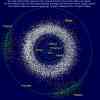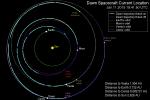The asteroid belt, or Main Belt, sits, more or less, between the orbits of Mars and Jupiter, with most asteroids between about 2.06 and 3.3 astronomical units (310 to 500 million km) from the Sun. Once thought to be the remains of a disintegrated planet, it is now understood to be the remnant of a failed planet. Originally, when the solar system formed, the amount of material in the belt is thought to have been comparable to the mass of the Earth. Very soon after its formation, perhaps in the first few million years, at least 99.9% of the mass was ejected due to gravitational disturbances from Jupiter and Mars. Instead of relatively gentle collisions between the planetesimals, allowing them to accrete, the impacts were highly energetic causing them to disintegrate into smaller pieces. Thus, much of the belt comprises billions of very small pebbles and dust. Over 200 asteroids have been identified that are larger than about 100 km (60 miles) at their widest, and there are probably at least one to one and a half million larger than 1 km across. While most of the asteroids are rocky, there is a group of comet like objects within the outer reaches of the main belt. They formed beyond the point where water froze in the early days of the solar system, beyond about 400 million km from the Sun, so were able to accumulate ice. Many Earth scientists suggest that out gassing of water from the interior of the early Earth would be insufficient to form its oceans, so it is possible that some of these comets may have collided with the Earth and provided the necessary water.
The Hilda asteroids are three groups of asteroids, each in a roughly triangular formation, that are in a 2:3 orbital resonance with Jupiter. That is they orbit the sun three times in the time it takes Jupiter to orbit twice. At any time, one group is directly opposite Jupiter, while the other two lead or trail Jupiter by 60 degrees, as shown in the diagram (below, right). These are the L4 and L5 Lagrangian points. The Jupiter Trojan asteroids are two groups that actually orbit the Sun within, approximately, Jupiter's orbit. They are found at the L4, "Greek", and L5, "Trojan", Lagrangian points, but are further out than the Hildas. 588 Achilles is a Trojan asteroid about 135½ miles across.
The four largest asteroids, Ceres, Vesta, Pallas, and Hygiea, represent more than 50% of the total mass in the belt. There are also many large groups of asteroids where the members within each group appear to have similar origins.
NASA launched the Dawn space probe on September 27th 2007. On July 15th 2011, Dawn went into orbit around the Asteroid Vesta. NASA published daily photographs which can be found here. From May 2012, Dawn started to spiral away from Vesta to a higher level orbit. By early September 2012, Dawn had left Vesta orbit, and spent 2013 & 2014 using its Ion thrusters to head towards the dwarf planet Ceres. Dawn arrived at Ceres in the Spring of 2015. Having depleted its hydrazine propellant on Oct.ober 31st 2018, contact with the spacecraft was lost, and the mission terminated.
The Hilda asteroids are three groups of asteroids, each in a roughly triangular formation, that are in a 2:3 orbital resonance with Jupiter. That is they orbit the sun three times in the time it takes Jupiter to orbit twice. At any time, one group is directly opposite Jupiter, while the other two lead or trail Jupiter by 60 degrees, as shown in the diagram (below, right). These are the L4 and L5 Lagrangian points. The Jupiter Trojan asteroids are two groups that actually orbit the Sun within, approximately, Jupiter's orbit. They are found at the L4, "Greek", and L5, "Trojan", Lagrangian points, but are further out than the Hildas. 588 Achilles is a Trojan asteroid about 135½ miles across.
The four largest asteroids, Ceres, Vesta, Pallas, and Hygiea, represent more than 50% of the total mass in the belt. There are also many large groups of asteroids where the members within each group appear to have similar origins.
NASA launched the Dawn space probe on September 27th 2007. On July 15th 2011, Dawn went into orbit around the Asteroid Vesta. NASA published daily photographs which can be found here. From May 2012, Dawn started to spiral away from Vesta to a higher level orbit. By early September 2012, Dawn had left Vesta orbit, and spent 2013 & 2014 using its Ion thrusters to head towards the dwarf planet Ceres. Dawn arrived at Ceres in the Spring of 2015. Having depleted its hydrazine propellant on Oct.ober 31st 2018, contact with the spacecraft was lost, and the mission terminated.
Solar System -
The Asteroid Belt
Description
The main asteroid belt, shown in white, is located between the orbits of Mars and Jupiter. The three Hilda groups are the orange triangular groupings just inside the orbit of Jupiter, and the two Jovian Trojans are shown in green; the "Greeks" leading and the "Trojans" trailing.
Dawn's trajectory. The key on the expanded image explains what the different lines & colors represent.



